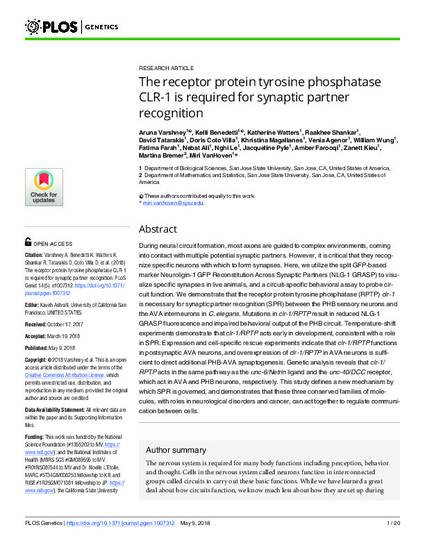
Article
The receptor protein tyrosine phosphatase CLR-1 is required for synaptic partner recognition
PLoS Genetics
(2018)
Abstract
During neural circuit formation, most axons are guided to complex environments, coming into contact with multiple potential synaptic partners. However, it is critical that they recognize specific neurons with which to form synapses. Here, we utilize the split GFP-based marker Neuroligin-1 GFP Reconstitution Across Synaptic Partners (NLG-1 GRASP) to visualize specific synapses in live animals, and a circuit-specific behavioral assay to probe circuit function. We demonstrate that the receptor protein tyrosine phosphatase (RPTP) clr-1 is necessary for synaptic partner recognition (SPR) between the PHB sensory neurons and the AVA interneurons in C. elegans. Mutations in clr-1/RPTP result in reduced NLG-1 GRASP fluorescence and impaired behavioral output of the PHB circuit. Temperature-shift experiments demonstrate that clr-1/RPTP acts early in development, consistent with a role in SPR. Expression and cell-specific rescue experiments indicate that clr-1/RPTP functions in postsynaptic AVA neurons, and overexpression of clr-1/RPTP in AVA neurons is sufficient to direct additional PHB-AVA synaptogenesis. Genetic analysis reveals that clr-1/RPTP acts in the same pathway as the unc-6/Netrin ligand and the unc-40/DCC receptor, which act in AVA and PHB neurons, respectively. This study defines a new mechanism by which SPR is governed, and demonstrates that these three conserved families of molecules, with roles in neurological disorders and cancer, can act together to regulate communication between cells.
Disciplines
Publication Date
May 9, 2018
DOI
10.1371/journal.pgen.1007312
Publisher Statement
This article was published in PLoS Genetics, volume 14, issue 5, 2018, and can also be found online at this link.
© 2018 Varshney et al. This is an open access article distributed under the terms of the Creative Commons Attribution License, which permits unrestricted use, distribution, and reproduction in any medium, provided the original author and source are credited.
Citation Information
Aruna Varshney, Kelli Benedetti, Katherine Watters, Raakhee Shankar, et al.. "The receptor protein tyrosine phosphatase CLR-1 is required for synaptic partner recognition" PLoS Genetics Vol. 14 Iss. 5 (2018) ISSN: 1553-7390 Available at: http://works.bepress.com/miri_vanhoven/12/
Creative Commons license

This work is licensed under a Creative Commons CC_BY International License.
